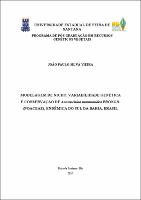| Compartilhamento |


|
Use este identificador para citar ou linkar para este item:
http://tede2.uefs.br:8080/handle/tede/613| Tipo do documento: | Dissertação |
| Título: | Modelagem de nicho, variabilidade genética e conservação de Anomochloa maranteidea Brongn (Poaceae) endêmica do sul da Bahia, Brasil |
| Autor: | Vieira, João Paulo Silva  |
| Primeiro orientador: | Oliveira, Reyjane Patrícia de |
| Resumo: | O gênero Anomochloa Brongn. inclui uma única espécie, A. marantoidea Brongn., reconhecidamente a mais antiga entre as gramíneas viventes. É uma espécie rara, endêmica da Mata Atlântica do sul do estado da Bahia com apenas duas populações conhecidas até pouco tempo, ambas com poucos indivíduos e nenhuma em área protegida, sendo considerada criticamente ameaçada de extinção. O conhecimento sobre essa espécie é de suma importância para compreender a evolução dentro da família, e assim, o presente trabalho visou ampliar o conhecimento acerca da extensão da distribuição geográfica da mesma e avaliar suas áreas potenciais de ocorrência, bem como conhecer os níveis de diversidade e ameaças genéticas resultantes do pequeno tamanho populacional, dados essenciais para programas que visem sua conservação. Duas novas populações foram localizadas recentemente e o nicho ecológico modelado não divergiu da distribuição esperada, indicando uma alta restrição climática e reafirmando a raridade da espécie. O índice de cobertura vegetal e a precipitação foram os principais requisitos ambientais a influenciar sua distribuição tão restrita. Os níveis de diversidade genética nas populações inferidos por marcadores moleculares indicam que a espécie tem capacidade para responder imediatamente bem em curto prazo e que um plano de conservação pode ser eficiente em manter a atual diversidade específica. Esta diversidade se mostrou relacionada com tamanho populacional, assim, propágulos para o estabelecimento de novas populações em sítios climaticamente adequados devem ser obtidos das maiores populações. Análises de estruturação genética sugerem fragmentação recente e indicam baixo fluxo gênico entre as populações conhecidas da espécie, com consequentes altos níveis de endogamia, por isso é recomendado fluxo gênico mediado por atividade humana entre as populações para evitar depressão endogâmica. É hipotetizado que diferenças genéticas entre as populações são causadas majoritariamente por deriva aleatória, o que tornou populações com menos indivíduos mais diferenciadas geneticamente daquela com o maior número. Isso implica que um número mínimo de indivíduos (~100) é desejável para evitar redução na diversidade genética das populações. |
| Abstract: | The genus Anomochloa Brongn. includes a single species, A. marantoidea Brongn., known as the earliest extant grass. It is a rare species from the Brazilian Atlantic rainforest, endemic to the southern Bahia. Only two populations were discovered so far, occurring out protected areas with few individuals registered, thus, A. marantoidea is considered critically threatened with extinction. The study of this species is highly important to understand evolutionary processes within Poaceae family. The present study aimed to increase the knowledge about its geographic range, to evaluate its potential areas of occurrence and to access its genetic diversity, detecting probable genetic threats as a result of its small population size. These data are essential for the development of conservation programs. Two new populations were recently discovered and the modeled ecological niche to A. marantoidea did not diverge from the expected geographical extent, denoting high climatic restriction and reasserting its rarity. The variables Index of Tree Cover and Rainfall are the main components that influence its restricted distribution. The levels of genetic diversity within the populations accessed by molecular markers indicate that A. marantoidea exhibits capacity for favorable response in short time and a conservation plan may be efficient to maintain its current genetic diversity. This diversity is correlated to the population size, for this reason, the propagules necessary for establishing new populations in climatically suitable sites must be originated from the largest populations. Genetic structure analysis suggests recent fragmentation and low gene flow among populations showing high levels of inbreeding. In this way, we recommend human mediated gene flow between the populations in order to mitigate the risks of inbreeding depression. It is hypothesized that the genetic differences among populations are caused mostly by random drift, resulting in populations with few individuals more genetically differentiated than the large ones. This implies that a minimum number of individuals (~100) is desirable to avoid the decrease of genetic diversity in populations. |
| Palavras-chave: | Mata Atlântica Maxent ISSR espécie rara Atlantic Forest rare species |
| Área(s) do CNPq: | CIENCIAS BIOLOGICAS::GENETICA |
| Idioma: | por |
| País: | Brasil |
| Instituição: | Universidade Estadual de Feira de Santana |
| Sigla da instituição: | UEFS |
| Departamento: | DEPARTAMENTO DE CIÊNCIAS BIOLÓGICAS |
| Programa: | Mestrado Acadêmico em Recursos Genéticos Vegetais |
| Citação: | VIEIRA, João Paulo Silva. Modelagem de nicho, variabilidade genética e conservação de Anomochloa maranteidea Brongn (Poaceae) endêmica do sul da Bahia, Brasil. 2017. 114 f. Dissertação (Mestrado Acadêmico em Recursos Genéticos Vegetais) - Universidade Estadual de Feira de Santana, Feira de Santana, 2017. |
| Tipo de acesso: | Acesso Aberto |
| URI: | http://localhost:8080/tede/handle/tede/613 |
| Data de defesa: | 29-Set-2017 |
| Aparece nas coleções: | Coleção UEFS |
Arquivos associados a este item:
| Arquivo | Descrição | Tamanho | Formato | |
|---|---|---|---|---|
| Dissertação Pos banca Final.pdf | Arquivo de Texto Completo | 10,59 MB | Adobe PDF |  Baixar/Abrir Pré-Visualizar |
Os itens no repositório estão protegidos por copyright, com todos os direitos reservados, salvo quando é indicado o contrário.




